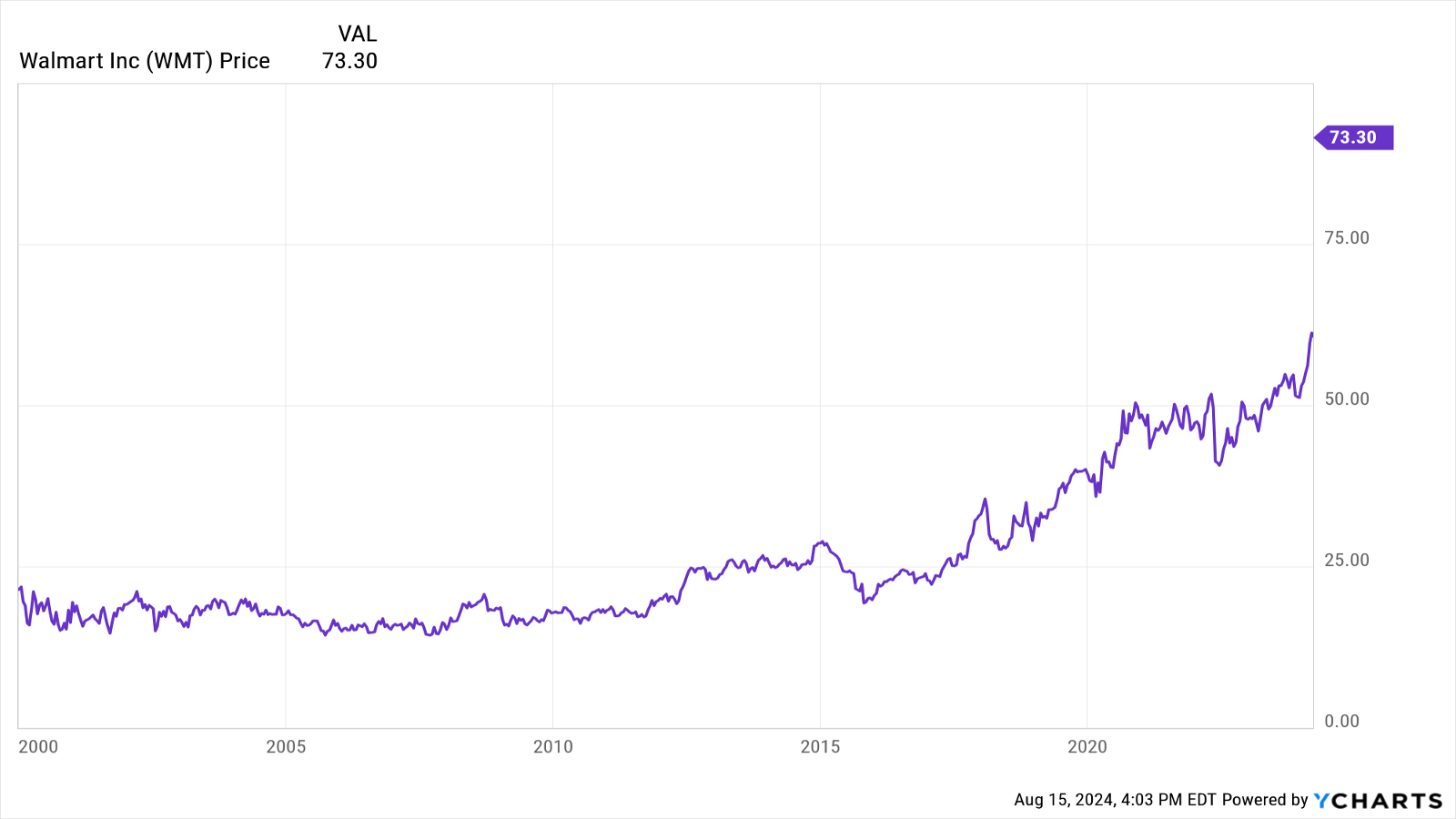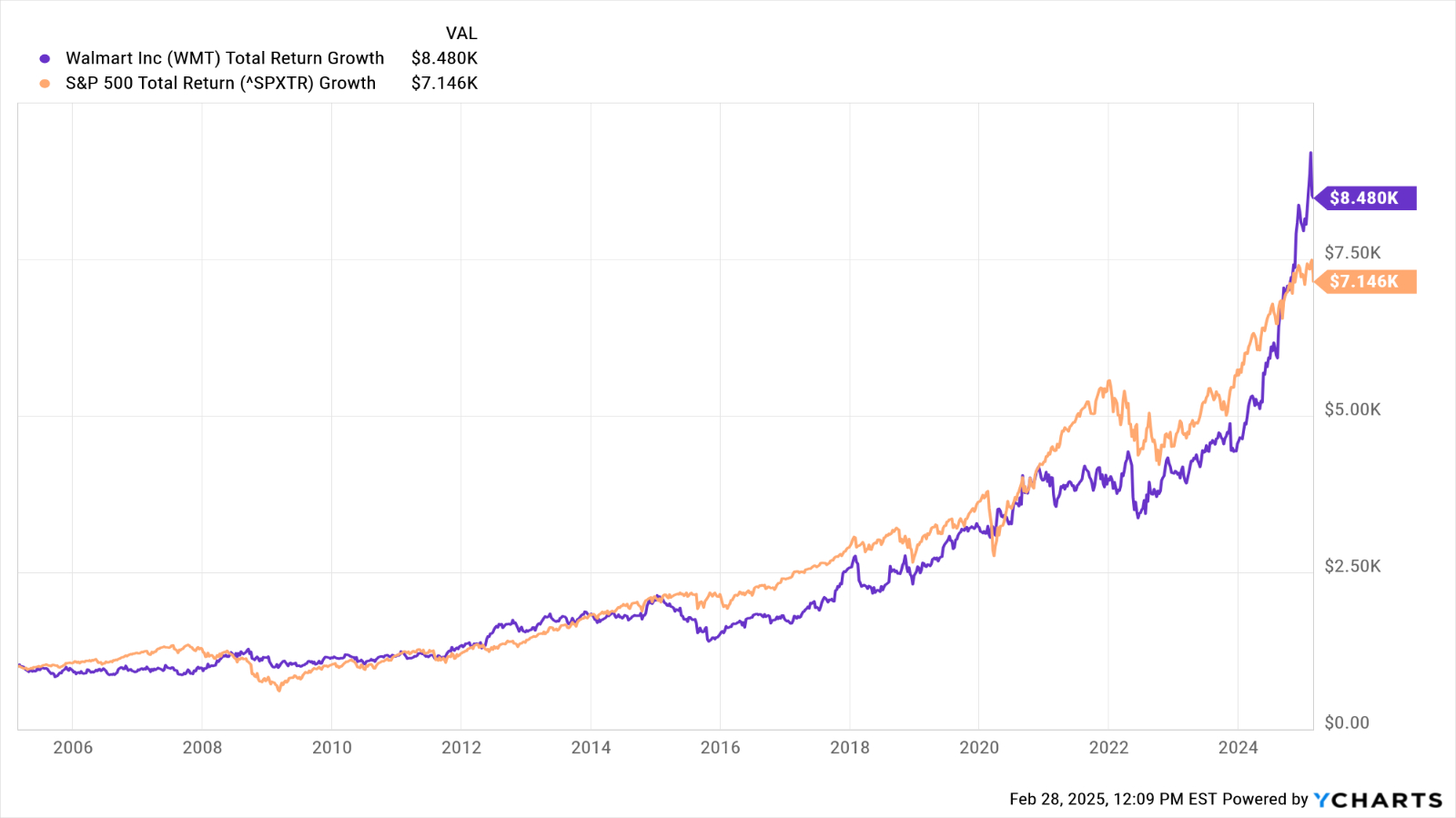If You'd Put $1,000 Into Walmart Stock 20 Years Ago, Here's What You'd Have Today
Walmart stock barely beats the broader market over the past couple of decades.



When it comes to blue chip stocks that pay dividends and play defense, Walmart's (WMT) reputation is pretty tough to beat. And with the near-term outlook for stocks becoming increasingly opaque, it's understandable if investors are tilting toward more defensive names, such as WMT, these days.
As a low-beta stock, Walmart stock does tend to hold up better than the broader market when everything is selling off. Walmart's fundamentals are essentially defensive, too. As an anchor of the consumer staples sector, Walmart sees comparatively stable demand through the business cycle.
Walmart is also indisputably one of the best dividend stocks for dependable dividend growth. This member of the S&P 500 Dividend Aristocrats has increased its payout annually for more than half a century. For those reasons and more, Walmart ranks as one of analysts' top-ranked Dow Jones stocks.

Sign up for Kiplinger’s Free E-Newsletters
Profit and prosper with the best of expert advice on investing, taxes, retirement, personal finance and more - straight to your e-mail.
Profit and prosper with the best of expert advice - straight to your e-mail.
Walmart's defensive characteristics certainly came in handy in 2022. The S&P 500 generated a total return (price change plus dividends) of -18.1%, a historically bad result. On the other hand, Walmart's total return came to -0.5% – or essentially flat – to beat the broader market by more than 17 percentage points.
The other side of WMT's defensive coin can be seen in its performance during 2023's remarkable rally. While the S&P 500 returned more than 26%, Walmart returned less than 13%.
As for 2024, WMT beat the broader market by nearly 50 percentage points, helped by resiliency in the labor market and consumer spending.
Sadly for long-term shareholders, the past couple of decades have delivered more of a 2023-type performance than what WMT stock has been up to recently.
A torrid run in the 1990s, the market's secular preference for growth over value, and worries about Walmart's place in an increasingly digital world conspired to make WMT stock a long-time market laggard.
The bottom line on Walmart stock
Walmart stock was actually one of the best stocks of the 30 years between 1990 and 2020, but as you can see in the chart below, WMT basically traded sideways for the first decade-plus of the 21st century.

Walmart shares went nowhere for a long time, but then that's not necessarily unusual given how far and fast they appreciated during the bubblicious 90s. Between the beginning of 1997 and the end of 1999, WMT gained more than 500% on a price basis. The broader market didn't quite double over the same span.
Also weighing on WMT during the first decade of the new century was the threat from e-commerce. Walmart responded by becoming the second largest e-commerce retailer in the U.S. after Amazon.com (AMZN) – albeit a distant second. Walmart got serious about its digital strategy sometime around 2006, but it took a while for what was regarded as "show-me" story to ultimately prove successful.
Whatever the causes, that lost decade on Walmart's stock chart really hurts its long-term results. Over the past 20 years, WMT stock has generated an annualized total return of 11.3% vs 10.3% for the S&P 500.
And even then, that one percentage point of outperformance emerged only at the end of 2024. To get a sense of what this sort of ride looks like on a stock chart, see the image below.

The chart illustrates the disconcerting fact that if you invested $1,000 in Walmart stock 20 years ago, today it would be worth about $8,500. The same thousand bucks invested in an S&P 500 ETF would be worth somewhere in the neighborhood of $7,150 today.
For its entire history as a publicly traded company, WMT's annualized total return does beat the broader market by almost 8 percentage points. Over the more realistic time frame of the past 20 years, however, there's no way around it: Walmart has been buy-and-hold blech.
More Stocks of the Past 20 Years
- If You'd Put $1,000 Into Nvidia Stock 20 Years Ago, Here's What You'd Have Today
- If You'd Put $1,000 Into Microsoft Stock 20 Years Ago, Here's What You'd Have Today
- If You'd Put $1,000 Into Apple Stock 20 Years Ago, Here's What You'd Have Today
Get Kiplinger Today newsletter — free
Profit and prosper with the best of Kiplinger's advice on investing, taxes, retirement, personal finance and much more. Delivered daily. Enter your email in the box and click Sign Me Up.

Dan Burrows is Kiplinger's senior investing writer, having joined the august publication full time in 2016.
A long-time financial journalist, Dan is a veteran of MarketWatch, CBS MoneyWatch, SmartMoney, InvestorPlace, DailyFinance and other tier 1 national publications. He has written for The Wall Street Journal, Bloomberg and Consumer Reports and his stories have appeared in the New York Daily News, the San Jose Mercury News and Investor's Business Daily, among many other outlets. As a senior writer at AOL's DailyFinance, Dan reported market news from the floor of the New York Stock Exchange.
Once upon a time – before his days as a financial reporter and assistant financial editor at legendary fashion trade paper Women's Wear Daily – Dan worked for Spy magazine, scribbled away at Time Inc. and contributed to Maxim magazine back when lad mags were a thing. He's also written for Esquire magazine's Dubious Achievements Awards.
In his current role at Kiplinger, Dan writes about markets and macroeconomics.
Dan holds a bachelor's degree from Oberlin College and a master's degree from Columbia University.
Disclosure: Dan does not trade individual stocks or securities. He is eternally long the U.S equity market, primarily through tax-advantaged accounts.
-
 6 Stunning Waterfront Homes for Sale Around the US
6 Stunning Waterfront Homes for Sale Around the USFrom private peninsulas to lakes, bayous and beyond, Kiplinger's "Listed" series brings you another selection of dream homes for sale on the waterfront.
By Charlotte Gorbold Published
-
 Six Reasons to Disinherit Someone and How to Do It
Six Reasons to Disinherit Someone and How to Do ItWhether you're navigating a second marriage, dealing with an estranged relative or leaving your assets to charity, there are reasons to disinherit someone. Here's how.
By Donna LeValley Published
-
 Should You Still Wait Until 70 to Claim Social Security?
Should You Still Wait Until 70 to Claim Social Security?Delaying Social Security until age 70 will increase your benefits. But with shortages ahead, and talk of cuts, is there a case for claiming sooner?
By Evan T. Beach, CFP®, AWMA® Published
-
 Retirement Planning for Couples: How to Plan to Be So Happy Together
Retirement Planning for Couples: How to Plan to Be So Happy TogetherPlanning for retirement as a couple is a team sport that takes open communication, thoughtful planning and a solid financial strategy.
By Andrew Rosen, CFP®, CEP Published
-
 Market Turmoil: What History Tells Us About Current Volatility
Market Turmoil: What History Tells Us About Current VolatilityThis up-and-down uncertainty is nerve-racking, but a look back at previous downturns shows that the markets are resilient. Here's how to ride out the turmoil.
By Michael Aloi, CFP® Published
-
 Stock Market Today: Stocks Surge to Close a Volatile Week
Stock Market Today: Stocks Surge to Close a Volatile WeekIt was another day with a week's worth of both news and price action, but it ended on a strongly positive note.
By David Dittman Published
-
 Home Insurance: How to Cut Costs Without Losing Coverage
Home Insurance: How to Cut Costs Without Losing CoverageNatural disasters are causing home insurance premiums to soar, but don't risk dropping your coverage completely when there are ways to keep costs down.
By Jared Elson, Investment Adviser Published
-
 Markets Roller Coaster: Resist the Urge to Make Big Changes
Markets Roller Coaster: Resist the Urge to Make Big ChangesYou could do more harm than good if you react emotionally to volatility. Instead, consider tax-loss harvesting, Roth conversions and how to plan for next time.
By Frank J. Legan Published
-
 Why Homeowners Insurance Has Gotten So Very Expensive
Why Homeowners Insurance Has Gotten So Very ExpensiveThe home insurance industry is seeing more frequent and bigger claims because of weather, wildfires and other natural disasters.
By Karl Susman, CPCU, LUTCF, CIC, CSFP, CFS, CPIA, AAI-M, PLCS Published
-
 Stock Market Today: Uncertainty Proliferates: Dow Loses 1,014 Points
Stock Market Today: Uncertainty Proliferates: Dow Loses 1,014 PointsWeaker-than-expected consumer inflation data wasn't enough to stabilize sentiment during another volatile day for financial markets.
By David Dittman Published